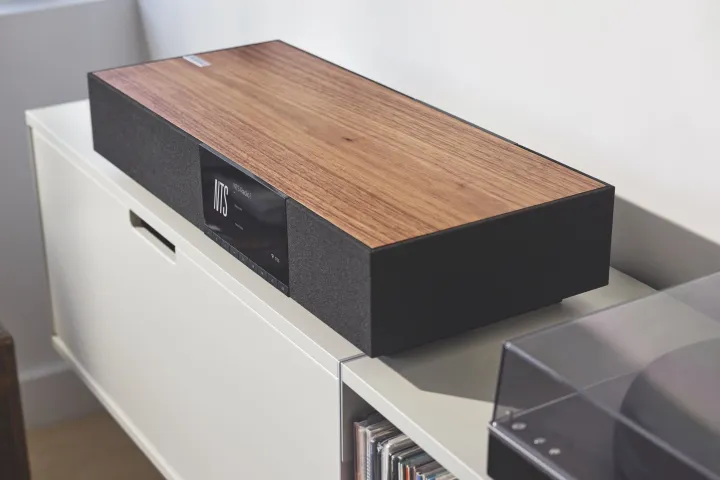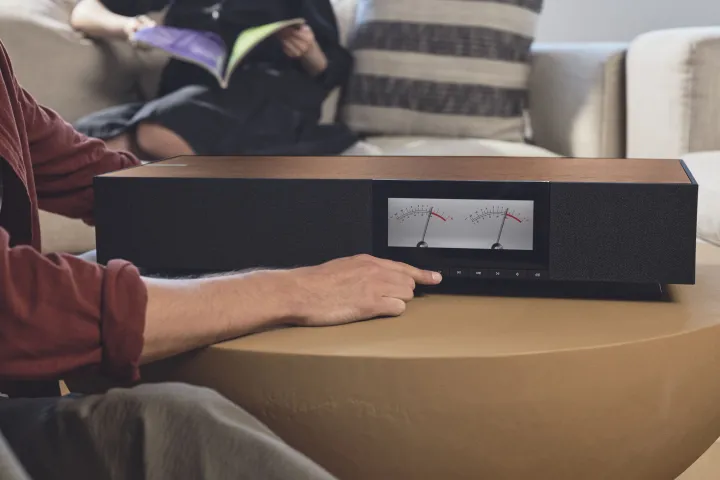Cambridge Audio’s new Evo One wireless streaming music speaker is a 15-driver beast that has more in common with most high-end soundbars. It’s available starting August 9 for $1,500.
The Evo One is eye-catching in the best possible way, with a wood veneer top and a 6.8-inch color screen, which makes it a larger sibling to the Evo 150 streaming integrated amplifier. It may be challenging to find the right spot for it, however. At 26.6 inches wide and 11.4 inches deep, it’s going to require a fair amount of space. And at 32 pounds, with its own built-in plinth-style stand, you won’t be wall-mounting it. It comes with its own dedicated remote.

Behind its fabric grilles lies a huge array of 15 drivers powered with up to 50 watts of class D amplification per unit. There are four 1-inch tweeters, four 2.25-inch mid-range drivers, and six 2.75-inch long-throw woofers. Six of those drivers are front-facing, but there are also three drivers on each wing, plus two of the woofers are oriented out the rear of the speaker.

This kind of arrangement is what we’d expect to see on a soundbar like the Sennheiser Ambeo Soundbar Plus, which coincidentally shares the same $1,500 price as the Evo One. According to Cambridge Audio, it’s an omnidirectional audio experience. “There’s no need to sit in a sonic ‘sweet spot’ as you would with most wireless speakers – with Evo One, every seat in the room is treated to glorious sound,” the company told us in an email.
Cambridge Audio feels the Evo One’s primary mission is to be a top-notch music system (it even has a dedicated phono input for moving-magnet cartridge turntables), but with an available HDMI ARC/eARC input, it’s obvious that TV audio is also part of its attraction.

With both dual-band Wi-Fi ac and Ethernet, the Evo One supports a variety of streaming options including Apple AirPlay 2, Google Cast, DLNA, Spotify Connect, and Tidal Connect. There’s also easy access from Deezer and Qobuz apps. It’s also Roon-ready for folks who are fans of that music management and streaming platform.
The speaker can support a variety of music file formats from streaming services, your local network, or an attached storage device using the USB-A port on the rear. These include WAV, FLAC, ALAC, AIFF, DSD (DSF and DFF), WMA, MP3 (CBR and VBR), AAC, HE AAC and AAC+ (CBR and VBR), plus OGG Vorbis.

When using the optical or HDMI port, the onboard digital-to-analog converter (DAC) can decode up to 24-bit/192kHz, but this goes up to 32-bit/384kHz when accessing the USB port or your network music collection, including up to DSD128.
One thing that we still need to figure out is what kind of audio formats the Evo One is able to process from a TV over HDMI eARC. The listed specs don’t include any mention of Dolby Audio (either Dolby Digital 5.1 or Dolby Atmos), DTS:X, or any kind of surround sound formats.
We’ll update this post as soon as we learn more.
Services Marketplace – Listings, Bookings & Reviews